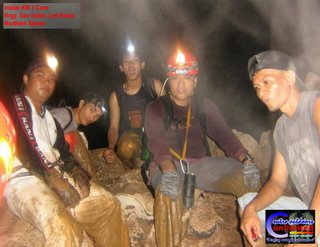 IN PHOTO: Cavers' participants of the recent 4th Annual Congress in the Visayas Caves held in Las Navas, Northern Samar took a rest after hours of navigating 'muddy' chambers of the KM. 3 Cave.
IN PHOTO: Cavers' participants of the recent 4th Annual Congress in the Visayas Caves held in Las Navas, Northern Samar took a rest after hours of navigating 'muddy' chambers of the KM. 3 Cave._________________
Sitting at the center is Mr. Bruce N. Ragas, our prolific training partner, based in Cebu City.
In his last lecture, he brought to our awareness the topic "CAVING: The Subterranean Adventure."Here's some inputs of the lecture.
Basic Caving and Safety - Caving is the exploration of subterranean and underground passages for purposes of:
1.Adventure/sports/fun (horizontal, vertical, wet, dry, extreme, and technical)
2.Scientific studies and researches for cultural/social, ecological,hydrological, geological, eco-tourism,and anthropological/archeological values)
Caving is a potentially dangerous sport, but it can be made as safe as you want it to be. Meaning, unavoidable accidents are extremely rare; people make mistakes and they, or others, can get hurt because of those mistakes.
GENERAL RULES OF CAVING SAFETY.
1. Never go caving alone.
2. Take 3 sources of light.
3. Wear a helmet with a chin strap which will release under load.
4. Use rubber soled boots.
5. Dress warmly.
6. Take some energy food along.
7. Don’t go caving when you are sick.
8. Tell someone where you are going and your estimated time of return.
9. Minimize body/personal accessories.
10.Start caving with experienced cavers.
BASIC CAVING EQUIPMENT CHECKLIST:
*Lighting
1. A helmet mounted headlight of some kind, either carbide or battery powered.
2. Two heavily constructed, water-proof flashlights.
3. Alkaline or lithium batteries and spares for each flashlight, and your headlight, if electric (otherwise, spare carbide and a ziploc for spent carbide).
4. An extra bulb for each light (a repair kit with tip reamer if using carbide).
5. Short pieces of nylon cord for flashlight wrist loops.
6. A thick candle and waterproof matches or cyalume light stick.
*For Your Head
1. A knitted pull-over type hat.
2. A hardhat.
3. Something to tie up your hair if it's long.
*Clothing
1. Appropriate attire (Light weight, quick dry, non-sagging, durable)
*Footwear
1. Sneakers are marginally acceptable. Hiking, climbing or combat boots are much better.
2. Heavy socks. Wool is best.
*Miscellaneous
1. Plastic garbage bags
2. Swiss or lock blade knife
3. A liter or more of water in tough container
4. Food
5. A small bag to carry junk
6. Knee pads
7. Camera equipments
8. whistle
GOOD MANNERS IN CAVING:
1. Ask permission from the cave owner if it is located in a privately owned lot.
2. Keep to established routes, both underground or on the surface.
3. Do not litter or deface any cave.
4. Do not disturb the wildlife; salamanders, snakes, crickets, spiders or other forms of life.
5. Do not touch or damage cave formations which may have taken thousands of years to form.
6. Things brought in must be brought out.
BASIC CAVE GEOLOGY AND FORMATIONS:
Types of Caves:
Solution Caves
… are the most common type. This type of cave is formed very slowly by water in limestone or gypsum. The water actually dissolves the rock. As the passages get bigger and there is a faster water flow, water erosion becomes a factor. These are formed slowly and collapse rarely. The wide variety of rock formations and passages also make this type of cave the most popular.
Talus Caves
…are literally piles of boulders. They tend to be very confusing and are easy to get lost in. Also, the predominance of broken rock makes them very hard on your body. They tend to occur in mountainous areas, especially near cliffs made of a very strong rock, such as granite.
Ice Caves
… are generally restricted to glacial areas. They are so cold that they could be dangerous. However, ice formations of extreme beauty and delicacy are often found.
Volcanic or Lava Caves
…can be found near some volcanoes. They are passages which formed around and finally over flowing lava. Once insulated by the surrounding rock, the lava stayed hot enough to drain out when the eruption ceased, leaving a cave. These caves tend to be extremely jagged, and they can cut your clothes to ribbons.
THE CAVE FORMATIONS:
The different types of features that decorate the cave are collectively called cave formations or speleothems.
Samples of Cave Formations
Stalactites, Stalagmites, Columns, Soda Straws, Helectites, Bacon, Curtains/Drapes, Chandeliers, Cave Pearls, Flow Stones, Gypsum Crystals.
SINGLE ROPE TECHNIQUE (SRT)
…. is a skill employed with the aid of a singles rope and climbing hardwares to go safely up and down the rope.
… used mostly in vertical related works (e.g. caving, mountaineering, rock climbing, industrial works, etc)
ASCENDING TECHNIQUE
Prusik – The Basic
Classic Three Knot Climbing System (employ 3 knot systems)
Texas System (employ 3 knot system)
Rope Walker System
Mitchell System (employ 2-3 hand ascenders or jumars)
Frog System
TAKE NOTHING BUT PICTURES, LEAVE NOTHING BUT FOOTPRINTS, KILL NOTHING BUT TIME.
No comments:
Post a Comment